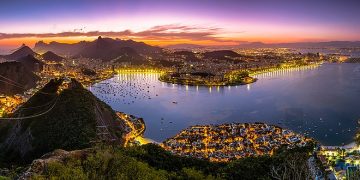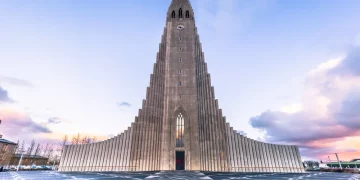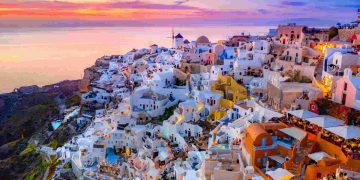Iceland, often referred to as “The Land of Fire and Ice,” is a country renowned for its otherworldly natural beauty. With its stark contrasts of glaciers, volcanoes, geysers, hot springs, and waterfalls, Iceland offers a truly unique experience for nature lovers and adventure seekers. Its dramatic landscapes seem almost surreal, and its geothermal activity and volcanic history give it a dynamic quality that is constantly changing and evolving. In this article, we will explore some of Iceland’s most awe-inspiring natural wonders, demonstrating just how breathtaking the country truly is.
1. The Majestic Waterfalls of Iceland
Iceland is home to some of the most spectacular waterfalls in the world, and these cascading wonders are often the first thing that draws visitors to the island.
- Gullfoss: Known as the “Golden Falls,” Gullfoss is one of Iceland’s most famous and powerful waterfalls. Located in the Hvítá river canyon, this two-tiered waterfall drops a total of 32 meters and creates a dramatic, thunderous roar as it plunges into the gorge below. The mist from the falls often creates beautiful rainbows on sunny days, adding to the majestic spectacle.
- Seljalandsfoss: This stunning waterfall, located along the south coast, is unique in that visitors can walk behind it, offering a rare and magical perspective of the cascade. The waterfall drops 60 meters and is framed by lush greenery, creating a picturesque scene that feels like something out of a fairytale.
- Skógafoss: Another iconic waterfall, Skógafoss stands at 62 meters tall and 25 meters wide. Its impressive power and beauty are matched by the surrounding landscape, which is dotted with green fields and volcanic terrain. The falls are particularly spectacular during the summer months when the surrounding flora is in full bloom.
These waterfalls, and countless others scattered across the country, showcase Iceland’s dramatic landscapes and serve as a reminder of the raw power of nature.
2. The Volcanic Landscapes: A Land Shaped by Fire
Iceland sits on the Mid-Atlantic Ridge, where the North American and Eurasian tectonic plates meet, making it one of the most volcanically active regions in the world. This geological activity has shaped the country’s landscape in remarkable ways, and volcanic eruptions continue to be a part of Iceland’s living history.
- Eyjafjallajökull: The eruption of Eyjafjallajökull in 2010 captured the world’s attention, as its ash cloud disrupted air travel across Europe. This volcano, which lies beneath an ice cap, is just one example of the dramatic volcanic activity that defines Iceland’s landscape. The region surrounding Eyjafjallajökull offers stunning views of glaciers, volcanic craters, and lava fields.
- Hekla: Known as one of Iceland’s most active volcanoes, Hekla is often called the “Gateway to Hell” in Icelandic folklore. Its eruptions, which have occurred throughout history, have shaped the land with vast lava fields and rugged landscapes. Hiking to the summit offers views of the surrounding volcanic terrain and distant glaciers.
- Krafla: Located in the northeastern part of Iceland, Krafla is a volcanic system that has erupted several times in the past few centuries. Visitors can explore the volcanic craters, fumaroles, and geothermal activity that characterizes the area, as well as the striking Lake Myvatn nearby. The combination of fiery geology and surreal landscapes creates an unforgettable experience for travelers.
These active volcanoes and the lava fields they leave behind are a testament to Iceland’s powerful natural forces.
3. The Glaciers: Ice Giants of Iceland
While Iceland may be known for its volcanic activity, it also boasts some of the most impressive glaciers in the world. These vast ice masses cover large portions of the country and have a profound impact on its landscapes.
- Vatnajökull Glacier: As the largest glacier in Europe by volume, Vatnajökull is a colossal ice cap that covers approximately 8% of Iceland’s total land area. The glacier is home to some of Iceland’s most striking natural wonders, including deep crevasses, ice caves, and towering ice formations. Vatnajökull also serves as the backdrop for several beautiful waterfalls, such as Svartifoss, which is surrounded by hexagonal basalt columns.
- Jökulsárlón Glacier Lagoon: One of the most famous sights in Iceland, Jökulsárlón is a glacial lake filled with floating icebergs. The striking blue and white icebergs create a surreal scene as they drift towards the ocean, where they eventually wash up on the black sand beaches of Diamond Beach. This area is an incredible spot for photography and wildlife watching, as seals are often seen swimming in the lagoon.
- Sólheimajökull: A part of the Mýrdalsjökull glacier, Sólheimajökull offers visitors the chance to hike on a glacier, experiencing the icy landscape up close. The glacier’s ice formations, crevasses, and panoramic views make it a must-see for adventurous travelers looking for a unique experience.

4. The Geothermal Wonders: Geysers and Hot Springs
Iceland’s geothermal activity is not only responsible for its volcanic landscapes but also for some of the most remarkable hot springs, geysers, and geothermal areas in the world.
- Geysir and Strokkur: Iceland is home to the original geyser, Geysir, after which all geysers are named. Although the Great Geysir is currently dormant, its neighbor, Strokkur, erupts every few minutes, shooting hot water up to 30 meters into the air. This powerful and mesmerizing natural phenomenon can be witnessed in the Geysir Geothermal Area in the Golden Circle, where hot springs, fumaroles, and bubbling mud pots create a dramatic landscape.
- Blue Lagoon: Perhaps the most famous geothermal spa in Iceland, the Blue Lagoon is located in a lava field and is fed by the waters from a nearby geothermal power plant. The lagoon’s milky blue waters, rich in silica and minerals, have healing properties, making it a popular destination for relaxation and rejuvenation. The contrast of the hot waters with the surrounding lava rocks and the cool, crisp air makes for an otherworldly experience.
- Myvatn Nature Baths: Located in the north of Iceland, the Myvatn Nature Baths are a lesser-known but equally stunning alternative to the Blue Lagoon. Situated near Lake Myvatn, this geothermal spa offers visitors a chance to soak in hot, mineral-rich waters while surrounded by volcanic landscapes, including lava formations and geothermal vents.
Iceland’s geothermal activity not only fuels the country’s natural beauty but also provides sustainable energy and unique opportunities for relaxation and wellness.
5. The Northern Lights: A Celestial Spectacle
One of the most magical experiences Iceland offers is the chance to witness the Aurora Borealis, or Northern Lights. This natural light display is caused by charged particles from the sun colliding with Earth’s magnetic field, creating stunning ribbons of green, purple, and pink light that dance across the night sky.
- Where to See the Northern Lights: Iceland is one of the best places in the world to see the Northern Lights, particularly from September to April. The best locations for viewing are away from the city lights, such as Þingvellir National Park, Jökulsárlón Glacier Lagoon, or remote areas of the Highlands.
- Why It’s Awe-Inspiring: The Northern Lights are truly one of nature’s most extraordinary phenomena. Watching the lights swirl and shift across the sky, casting an ethereal glow on the frozen landscape below, is an unforgettable experience that feels almost otherworldly.
Conclusion: A Land of Endless Wonder
Iceland’s natural wonders are undoubtedly some of the most awe-inspiring in the world. From the towering waterfalls and glaciers to the volcanic landscapes, geysers, and the celestial beauty of the Northern Lights, Iceland’s landscapes are a testament to the raw power and beauty of nature. The combination of fire and ice, along with the country’s geothermal activity, creates a dynamic and ever-changing environment that continually captivates travelers from all over the globe. Whether you are hiking across glaciers, soaking in hot springs, or gazing at the sky in search of the Northern Lights, Iceland’s natural wonders offer a sense of awe and wonder that is truly unparalleled.





















